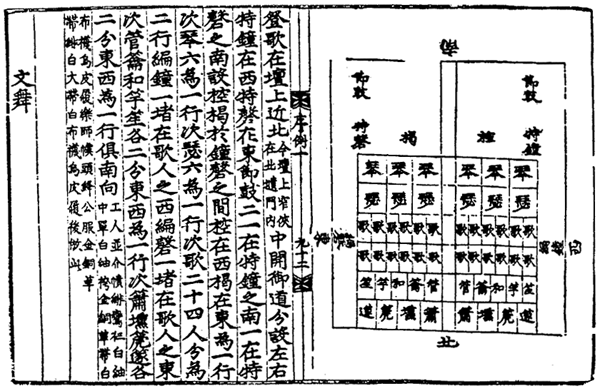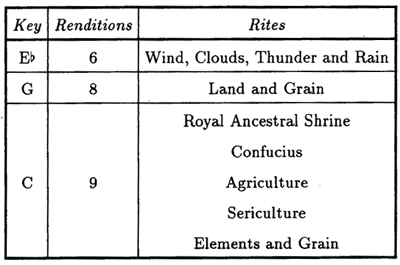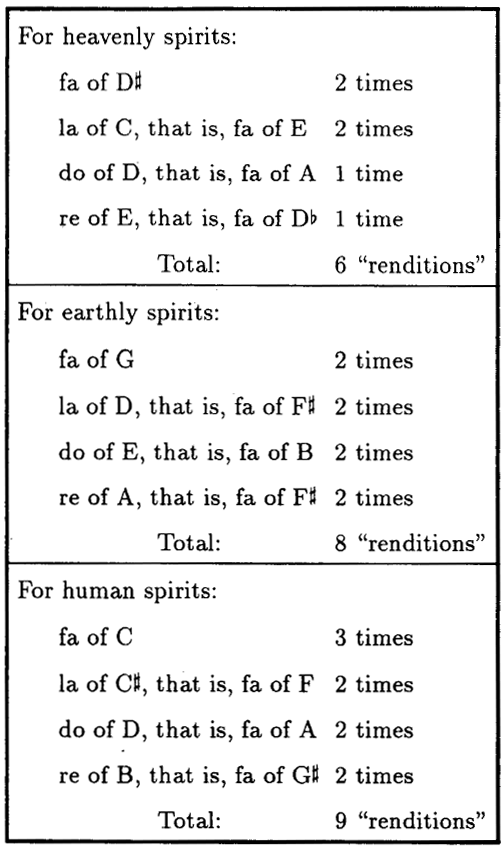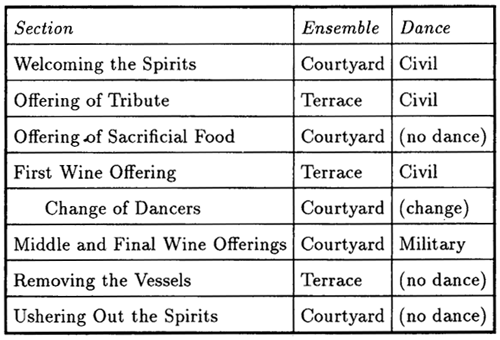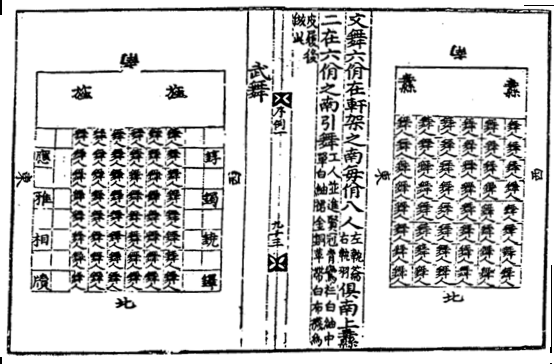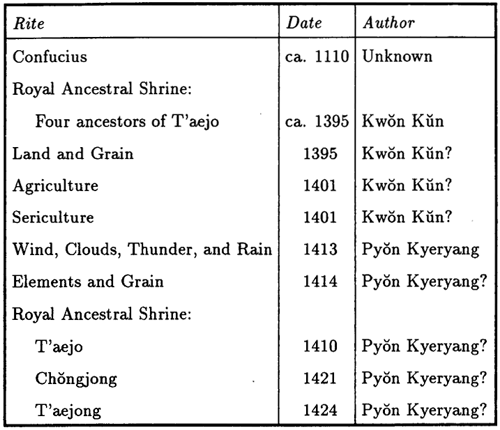State Sacrificial Rites
and Ritual Music
in Early Choson
By ROBERT C. PROVINE
Introduction
One of the most striking and distinctive types of music to be heard in
Korea today is the stately and venerable ritual music called aak.1 It is per-
formed at the semi-annual Sacrifice to Confucius (Sokchon) carried out at
the Munmyo ("Civil Shrine") in the grounds of Songgyun'gwan University in
Seoul,2 and occasionally in concerts and recordings of the Korean Traditional
Performing Arts Center (Kungnip kugagwon).3
This slender modern survival of an earlier substantial body of ritual prac-
tice is extremely fortunate, but it is also a potentially misleading basis on
which to generalize about the historical use of music in state rites: the Sac-
rifice to Confucius was itself rather an exceptional case amongst the state
sacrifical rites which used aak during the Choson dynasty (1392-1910), and
the modern performance, while remaining true to historical practices in many
ways, also deviates significantly from the historical norm. The purpose of
this essay is to describe the state sacrificial rites of early Choson in general
and to explain the blueprint by which ritual music was employed in them.
In my recent book Essays on Sino-Korean Musicology: Early Sources for
Korean Ritual Music (1988), I have already discussed the historical sources
used in this investigation and transcribed the music to be found in them.
In the Introduction to the book I included only a very brief discussion of
sacrificial rites, together with two charts: one simply lists the early Choson
state sacrificial rites, and the other presents an outline of the scheme by
which music was fit into the ritual programmes.4 In the present essay, I give
───────────
1 The word aak is used here in its strict historical meaning of a particular ritual music genre
of Chinese extraction, rather than in the vague modern meaning of Korean court music in
general. For a clarification of the term and aak's relationship to Chinese music, see Provine
1987.
2 On this ceremony, see Provine 1975, an article now rather out of date owing to recent musical
changes.
3 See, for example, Kungnip kugagwon 1983. The English name of the Center was formerly
National Classical Music Institute.
4 Provine 1988: 14-20.
the details of all the information in those two charts.
The Nature of Sacrificial Rites
In the Confucian tradition, a sacrificial rite is a ceremonial demonstration
of the duty of a proper gentleman to honour the spirits of his ancestors. One
is expected not only to always have Inward feelings of respect for ancestors,
but also to exhibit that respect in formal, timetabled rites. A ruler, such
as the emperor of China or the king of Korea, bears responsibility both
for his own sacrificial rites and for certain other state rites carried out on
behalf of the nation. Such extra rites were for spirits of less personal and
more general concern, such as those of land , grain, heavenly phenomena, and
dynastic founders. Not surprisingly, sacrificial rites at the state level were
considerably more magnificent and imposing than those at lower levels of the
social hierarchy.
Confucianism is not so much a religion as a code of conduct. In this it
differs, for example, from Korean shamanism, since the wise Confucian does
not necessarily believe in the reality or efficacy of the spirits as such. As the
classic Confucian text Liji (Book of Rites) says, "To treat the dead as dead
would show a lack of love and therefore cannot be done; to treat the dead as
living would show a lack of wisdom and likewise cannot be done." 5 In other
words, the moral purity and exemplary behaviour of the person carrying out
a formal rite such as a sacrificial rite are what is important, rather than his
belief in the existence of spirits or their ability to induce effects In the world
of the living. One's actions must be in keeping with one's place in society
and relationship to others, and they must be exemplary; by good example,
one inspires others to correspondingly fitting behaviour.
Even if the Confucians did not genuinely believe in the existence and
power of individual spirits, they did recognise the power of fate, generally
termed "heaven".6 Fate could be positively influenced by exemplary be-
haviour, and hence exceptional sacrificial rites might be carried out, say, in
face of prolonged drought, less to persuade a particular spirit to intercede on
behalf of humanity than to encourage fate to the same end.
In some cultures a sacrificial rite is one in which something of great value
(e.g. human life) is destroyed in order to gratify the perceived demands of
a malevolent spirit. The Confucian sacrificial rite is quite different: valuable
items are offered , but the "spirits" are treated as benevolent and the occasion
is considered "auspicious" (hence the generic term killye, "auspicious rites" ,
───────────
5 Liji 2.16b. Translation from Watson 1962:142. Bibliographic information on all primary
sources cited in this essay is given in Provine 1988.
6 On the role of heaven in Confucianism, see Hucker 1961:65-66.
for sacrificial rites). In Choson Korea, sacrificial rites were held to honour
members of the royal ancestral line; it is instructive, though, that two mon-
archs adjudged. by history to be villainous, Yonsan'gun (ruled 1494-1504)
and Kwanghaegun (1608-1623), were neither awarded posthumous kingly
titles nor enshrined in the Royal Ancestral Shrine (Chongmyo) where their
spirits might receive sacrificial rites.
Most of the types of sacrificial rites to be discussed below were introduced
into Korea from China during the Koryo dynasty (918-1392) or were Confu-
cian reformulations of kindred practices, such as ancestral worship, already
present in Korea. In Confucian ritual matters, Korea had the status of a
province of China rather than that of an independent nation - the Chinese
emperor was the ritual chief for the entire Chinese cultural sphere, and the
heads of state of surrounding "vassal" countries were considered to be dukes
of the Chinese court.7
The 1451 Koryosa(History of the Koryo Dynasty) contains information
on sacrificial rites in the Koryo period,8 but this book, written by Confucian
officials (Chong Inji and other) during the first half century of the succeeding
Choson dynasty, has been accused of Confucian bias. It is thus uncertain how
accurately it portrays Koryo ceremonies, and the printed descriptions may
well result from the Confucian writers' emphasis on the "better" aspects of
Koryo history or their dependence on written sources.
In any case, our purpose here is not to examine the development of
ritual performances from Koryo to Choson, but rather to survey the various
state sacrificial rites as performed (or at least as prescribed) in the time of
the famous King Sejong (ruled 1418-1450). My list comes primarily from
the 1474 Kukcho oryeui [Five Rites of the Nation] and Kukcho orye sorye
[Illustrated Rubrice for the Five Rites of the Nation], which purportedly
record the essence of the ritual system developed under Sejong's direction.
Numerous passages in the Sejong sillok (Annals of King Sejong)reveal that
there were many detailed refinements of specific ceremonies during his reign,
but apart from a few representative examples such details are beyond the
scope of this article.
As it happens, the historical developments of ceremonial programmes for
sacrificial rites and of the particular music to be used in them were largely
independent: the basic ritual frameworks were codified during the reign of
King T'aejong (1400-1418) and recorded by Ho Cho in the 1415 portion of
───────────
7 That the Koreans accepted this ritual, if not political status is evidenced by much of what,
follows in this essay. For example. the Koreans'reference to the Ming bock Hungwu Lizhi
[Ritual System of the Hungwu Period] is always to passages concerning "provincial" matters.
8 Chap. 59-63 and passim. For an analysis. see Yi Pomjik 1983.
the orye uiju [Five Rites],9 a predecessor of the Kukcho oryeui. These ritual
programmes specified when music was to be performed, but not which music.
The codification of aak in the early years of Sejong's reign was essentially a
formulation of suitable music to insert in predetermined ceremonial slots.
Categories of Sacrificial Rites
At the state level, sacrificial rites were divided into three main categories:
Great Rites (thesa), Medium Rites (chungsa), and Small Rites (sosa).10 In
Great Rites, three types of meat were sacrificed (ox, sheep, and pig) , together
with an offering of rice-cakes in many colours, a large variety of grains, other
foods, and cloth.11 Of central importance to the formal structure of the
ceremony were three ritual offerings of wine, and music (aak) was performed
during specified sections of the programme.
Medium Rites required only two types of meat (sheep and pig) , rice-cakes
in a few colours, and correspondingly lesser quantities of the other offerings.
The formal structure of the ceremony, however, was essential1y the same as
for Great Rites, with three offerings of wine and (with a couple of exceptions)
the performance of music. Numerically, Small Rites made up about half the
state sacrificial rites. In these, only one meat (pig) was sacrificed, and there
were no rice-cakes and few other offerings. Offerings of wine were variously
one or three, and music was rarely performed.
Sacrificial rites were performed either on specific dates in the (lunar)
calendrical year or on days divined (pok) as propitious. Great Rites were
carried out several times a year, while Small Rites were generally held only
once or twice. Since the rites were "auspicious" occasions, it was improper to
told them during periods of mourning after the death of Korean or Chinese
royalty.
Many of the rites were derived from Chinese precedents, and thus many of
the spirits honoured were from Chinese tradition. For example, the spirits of
───────────
9 Preserved in Sejong 128-131. On the publication history of the 1415/1451 Orye uiju, see
provine 1988:34-38. Here and below, the dynastic annals (sillok) are cited in footnotes
simply by the name of the king.
10 This discussion is distilled from the "Rubrics for the Auspicious Rites" (Killye sorye) in Ho
Cho's 1415 portion of the Orye uiju (Sejong 128) and from the "Auspicious Rites" section of
the Kukcho orye sorye of 1474. Hwang Kyongkwan 1967:11-19 gives a brief general discussion
of sacrificial rites, but is otherwise mostly concerned only with the Royal Ancestral Shrine
rites.
11 Charts of the presentation arraugements of the various offerings in a Great Rite are given in
Sejong 128.10b and Kukcho orye sorye 1.53a. Precise identification of the fifteenth-century
foods and grains is difficult; photographs of and information on the offerings in the modern
Sacrifice to Confucius may be found in Palmer 1984:47-49 and pl. 37-46.
Agriculture and Sericulture served in Korea were those of a legendary Chinese
minister and a Chinese queen, famed for their achievements in growing crops
and raising silkworms, Sacrifices for royal ancestors, on the other hand, were
for the Choson royal line and not the Chinese imperial line. The question
of whether Korean sacrificial rites should honour Korean or Chinese spirits
became a matter of contention at the Choson court, as evidenced by many
discussions recorded in the court Annals.
Each spirit was classified as heavenly (ch'onsin), earthly (chigi), or hu-
man (in'gwi). Broadly speaking, the spirits of stars or heavenly phenomena
(such as rain and thunder) were heavenly, terrestrial ones (such as mountains
and streams) were earthly, and those of deceased persons (such as Confucius
and royal ancestors) were human. In antiquity, sacrificial rites for heavenly
spirits were called sa (Chinese si), those to earthly spirits che (ji), and those
to human spirits hyang (xiang).12 The same terminology was used consis-
tently in fifteenth-century Korea in the Orye uiju, Kukcho oryeui, and other
writings.
King Sejong often expressed his view of the importance of all the sacri-
ficial rites, as in this statement of 1433: 13
Ceremonies for the Great Rites are rehearsed in a public location, and cer-
emonies for the Medium Rites are rehearsed at the places of sacrifice. But the
ceremonies for the Small Rites have gone unrehearsed - at the times of the per-
formances, there have been many alterations and errors. This has certainly been
unacceptable. I command that henceforth even the ceremonies of the Small Rites be
rehearsed, at the places of sacrifice, in order to assure consistency in the ceremonies.
The spirits honoured in these state sacrificial rites were not simply neg-
lected at times other than the prescribed performances. There were also
various lesser observances, generally on an occasional basis and not requir-
ing music. The Koje, for example, was a ceremony at the Royal Ancestral
Shrine (Chongmyo) in which significant events were reported to the spirits of
royal ancestors. Another ceremony held at the Royal Ancestral Shrine was
the Ch'onsin, in which the first fruit or grain produced in a year's crop was
offered to the royal ancestors; this rite was performed neither on a sched-
uled or divined date, but simply on the day after the harvest. Spirits could
also be served at locations other than the official shrines and altars - small
ceremonies of wine offerings, Chakhonje, for example, were held for royal
───────────
12 As in Zhouli (Rites of the Zhou Dynasty) 22.5a.
13 Sejong 61.32b (1438/int 8). In citing passages from the chronological parts of Annals, I give
lunar dates in the form year/month; intercalary months are iudicated with the abbreviation
int.
ancestors at their tombs and at special pavilions within the royal palaces. 14
Another lesser ceremony frequently mentioned in the Annals is the Kiuje
(Rite of Supplication for Rain). Performed during periods of drought in
hopes of bringing rainfall, it was held at various locations including moun-
tains and rivers near Seoul, the Royal Ancestral Shrine, and other altars and
shrines in the Seoul vicinity.15
The frequency with which performances of a rite are mentioned in the
Annals is not a reliable benchmark of significance. The Annals habitually
report new or extraordinary developments at court, often remaining silent
about regularly recurring events. Thus they include many court discussions
and memorials about rites, but often omit mention of regularly scheduled
performances of the rite, Extraordinary and lesser rites such as the four
mentioned just above are recorded in the Annals, while Great Rites are omit-
ted. A better gauge of a rite's importance is the space devoted to it in the
1415 Orye uiju and 1474 Kukcho oryeui. From these it is clear that, as
expected, much more attention was paid to the Great, Medium, and Small
sacrificial rites rather than to the lesser, occasional rites dedicated to the
same spirits.
List of Sacrificial Rites
In the following descriptions of individual sacrificial rites, emphasis is
on the Great and Medium sacrificial rites, in most of which ritual music
(aak) was performed. For completeness, there are short descriptions of the
non-musical Small Rites as well.16 The list is based mainly on the 1474
Kukcho oryeui (chapters 1 and 2) and its accompanying Kukcho orye sorge
(chapter 1). Other sources reveal few differences from this list.17 The sources
distinguish carefully between shrince (myo) and altars (tan), and I follow that
distinction here.
───────────
14 The Koje, Ch'onsin, and Chakhonje are described briefly in Hwang Kyonghwan 1967:79-81.
15 An example of performances of this rite with a successful outcome may be found in Sejong
28.26a(1425/6) through 29.4b(1425/7). The rite is examined at length in Murayama 1938:76 -
161.
16 Hwang Kyonghwan 1967:14-15 only lists the names of the rites.
17 For example, the 1415 Orye uiju(Sejong 128.1b-2a and 129-131); the 1451 Koryosa(chap.59-
63); the list of shrines and altars in the 1454 geographical appendix to the Sejong Annals
(Sejong 148. 1a-3a); the official prescribed list in the 1469 Kyongguk taejon (National Code)
3.34ab; and the historical, cumulative list in the Chungbo Munhon pigo [Expanded Edition of
the korean Encyclopedia of Documents and Institutions], chap.54-64).
Ⅰ. GREAT RITES
1. Sajik: Spirits of Land and Grain
The Spirit of Land (Sa) and Spirit of Grain (Chik), both "earthly" spirits,
were honoured together at a rite scheduled three times a year. Impetus for
the sacrificial rite comes from the idea that people need land in order to
stand and grain in order to live. The rite is essentially Chinese in origin, but
the Ming Hungwu lizhi [Ritual System of the Hungwu Period) specifies that
a "province" of China should honour its own local land and grain spirits.18
In addition to the generic Korean spirits of land and grain, the ceremony
served two named Chinese spirits: that of Earth (Houtushi) and that of
Grain (Houjishi).19
The altar of the Spirits of Land and Grain, like the shrine of the other
Great Rite (Royal Ancestral Shrine) normally performed in the Choson pe-
riod, was located within the city walls of Seoul. Situated west of the main
palace (Kyongbok kung) in a compound surrounded by a wall, it consisted
of two square earthen mounds, one for the land/Earth spirits and one for
the grain spirits, together with buildings for storing ritual paraphernalia and
musical instruments between performances. Figure 1 shows the compound
as depicted in the Kukcho orye sorye. 20 Like most of the other altars and
shrines, this double altar was rebuilt at various times during the Choson dy-
nasty. Though the sacrificial rite is now long discontinued, the last pair of
earthen mounds (designated an Historic Site) are still to be found in a small
public park in downtown Seoul.
2. Chongmyo: Primary Royal Ancestral Shrine, and
Yongnyongjon: Secondary Royal Ancestral Shrine
Ancestors and kings of the Choson dynasty royal line were honoured
at the Primary and Secondary Royal Ancestral Shrines,21 located east of the
palace and inside the city walls. According to a scheme borrowed from China,
Korean kings were meant to sacrifice primarily to five prior generations of
───────────
18 Zhang 1579:7.11ab. An example of Korean reliance on this work in connection with the Sajik
rite is found in Sejong 72.9b (1436/5).
19 Houtushi was the spirit of Goulung, Minister of Earth under the legendary emperor Zhuanxu
(traditional date twenty-fifth century B.C.). SimilarIy, Houjishi was the spirit of the Minister
of Agriculture under emperor Shun (twenty-third century B.C.). Basic classical references on
both may be found in Murohashi 1955: Ⅱ,425cd and 837bc.
20 Kukcho orye sorye 1.30ab.
21 During the Koryo dynasty and occasionally during Choson. the Chongmyo was referred to as
T'aemyo (Great Shrine). It was and is habitual to use the term Chongmyo collectively for
both shrines.
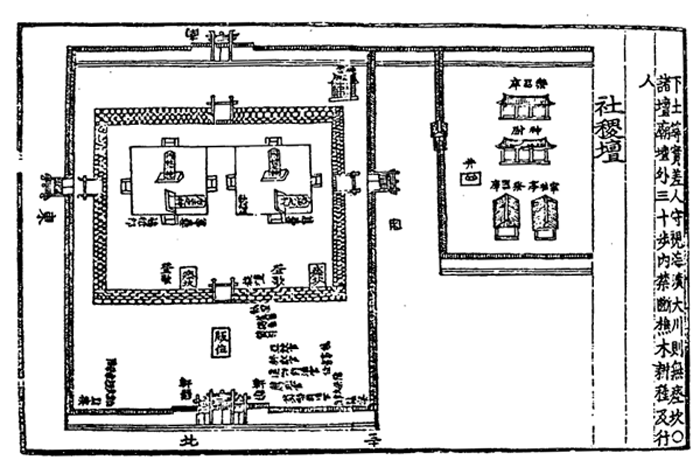
Figure 1:Altar of the Spirits of Land and Grain
male lineal ancestors and their wives, all of these being human spirits.22 The
practice in early Choson was to sacrifice to all preceding Choson rulers and
queens, plus the first four male ancestors of the first king, T'aejo.23 In keeping
with the Chinese guidelines, the Primary Shrine held the spirit tablets of the
reigning king's father and four preceding generations. The Secondary Shrine
held the tablets of those of T'aejo's ancestors who were beyond the five-
generation limit of the Primary Shrine.24
The Primary Shrine was built initially In 1395, the Secondary Shrine in
───────────
22 The scheme and its implementation in Korea is complicated and a separate study. Discussion
of the scheme and its basic terminology may be found in Sejong 11.21b-22a (1421/4) and
Chen 1090:67.17b-l8b. A brief statement in the classics is Liji (Book of Rites) 14.2ab.
23 For information on T'aejo's four ancestors, T'aejo himself, and his son T'aejong, see P. H. Lee
1975:passim.
24 Later in the 500-year dynasty this scheme was modified as the Secondary Shrine became
overfull. By the nineteenth century, the basic system was that the Primary Shrine included
the tablets of persons who satisfied all of three conditions: 1) were in the direct male lineage
of the reigning king. 2) actually sat on the throne,and 3) were not considered villainous. The
remaining tablets were held by the Secondary Shrine. During the nineteenth century, the
succession of kings did not follow a simple direct lineage, and the system was circumvented
under Kings Ch'olchong (ruled 1849-1863) and Kojong (1863-1907).

Figure 2:Primary Royal Ancestral Shrine
1421.25 Figure 2 shows the Primary Shrine as depicted in the Kukcho orye
sorye of 1474. 26 In 1430, when aak was codified for use in sacrificial rites,27
the Primary Shrine held five generation of Sejong's predecessors, and the
Secondary Shrine only a single pair of tablets (ancestor and wife), as shown
in Chart 1. 28
By 1474, the time of the Kukcho orye sorye, all four of T'aejo's en-
shrined ancestors had been transferred to the Secondary Shie, as sown in
Chart 2. 29
The regular sacrificial rites at the Primary Shrine occurred five times a
year, and the two scheduled Performances at the Secondary Shrine were held
in conjunction with two of the Primary Shrine rites. Both shrines were the
───────────
25 T'aejo 8.6a (1395/9) and Sejong 13.23b (1421/10). The death of King Chongjong in 1419
necessitated the construction of the Secondary Shrine. Both shrines were rebuilt and modified
a number of times during the dynasty. and the buildings remaining today (designated an
Historic Site) are an imposing sight. A photographic and architectural study of the extant
buildings is Kim Won 1977.
26 Kukcho orye sorye 1.34ab.
27 Explained in Provide 1988:141-171.
28 T'aejo's ancestors are named by their posthumous titles. The list is from Sejong 147.1a-2b.
29 Kukcho orye sorye 1.34b 35a.
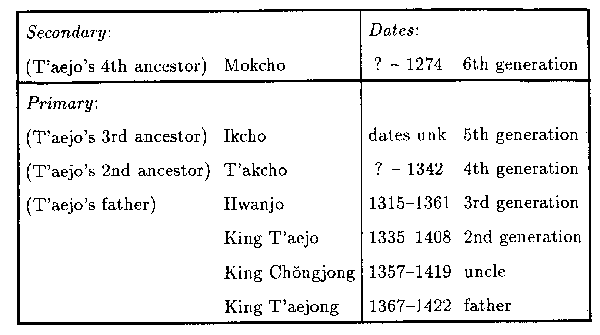
Chart 1: Royal Ancestral Shrines in 1430
site of numerous other lesser rites, such as the reporting of significant events
and offering of first fruit already mentioned. There were special ceremonies
for induction of new spirit tablets or transfer of tablets from Primary to
Secondary Shrines.
The sacrificial rite at the Royal Ancestral Shrines was dedicated to the
human spirits of Choson royal ancestry, but it was Chinese in conception and
ritual programme. Even the music, aak, performed during the ceremony in
the Sejong period was considered to be Chinese. Another set of sacrificial
rites was held for royal ancestors at a separate shrine called Munsojon,30
and these ceremonies were more spiritually Korean than those in the Royal
Ancestral Shrines,31 using tangak (Koreanized music of Chinese origin) and
hyangak (native Korean music) It was reported by complaining ministers
that the Munsojon even contained a Buddhist altar.32
In fact, King Sejong had reservations about the use of aak in the Royal
Ancestrl Shrine, as he expressed for example in 1430: 33
───────────
30 In fact, there ware at times several such shrines (e.g. the Kwanghyojon, Insojon,
and Wonmyo) and many complex name changes. Sometimes they were conbined into the
single shrine called Munsojon. See Sejong 58.10a (1432/10) and Kukcho orye sorye 1.35b-36a
(which has a drawing).
31 An official discussion of the contrast appears in Sejong 43.25b-26b (1429/3) .
32 As in Sejong 21.18a (1423/9), 59.13a (1433/1), and 121.6b, 11a, and 13a(1448/7).
33 Sejong 49.31b-32a (1430/9) .
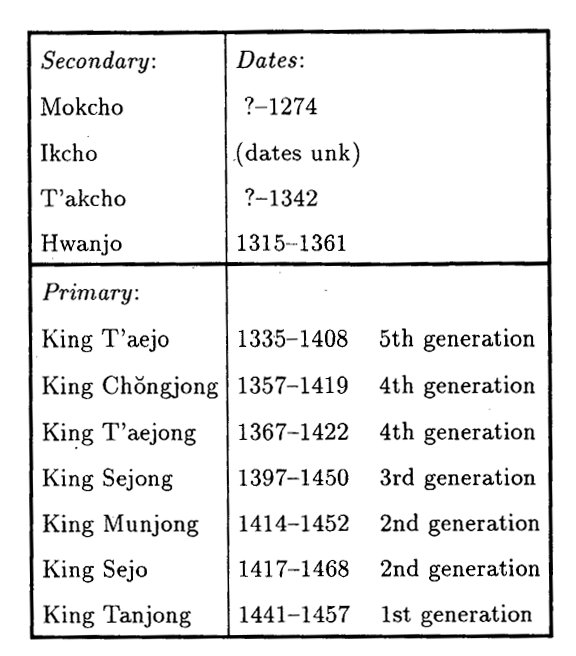
Chart 2: Royal Ancestral Shrines in 1474
Aak is fundamentally not Korean music. It is, in fact, Chinese music and
what Chinese people ordinarily hear: so it is appropriate for performance in their
sacrificial rites. When the people of our nation are alive, they listen to Korean music
(hyangak). but after they die. aak is performed [in sacrificial rites]. How can this
be explained?
Nevertheless, aak was the music initially codified for use in all the state
sacrificial rites which required music. In 1447, Sejong was personally involved
in the preparation of a new and large body of music for court use, based on
native or long Koreanized musical models. Sejong still felt that his ances-
tors should be honoured with Korean rather than Chinese music, and it is
recorded that he himself composed two long suites with vocal texts extolling
royal ancestors:Pot'aep'yong (in eleven movements) plaising civil accom-
plishments of the ancestors, and Chongdaeop (finteen movements) praising
their military achievements.34 Later, Sejong's son Sejo (ruled 1455-1468)
adapted the two suites for use in the Royal Ancestral Shrines in place of the
───────────
34 Sejong 116.22a (1447/6) and 138.1a. Notations of the music are preserved(in chapter 138.
former Chinese aak, and descendants of this version of the suites are still in
the modern repertory. 35
During performances of the Primary Royal Ancestral Shrine sacrificial
rite, an separate offering of wine honoured the spirit tablets in two small
additional shrines in the courtyard. One shrine was for various superinten-
dent spirits known as the Seven Sacrifices (Ch'ilsa); as in the case of the
spirits of Land and Grain (Sajik), these seven originated in China, 36 but
the spirits honoured in Korea were local. In some sources, the Seven Sac-
rifices is listed as a Small Rite, 37 but the Kukcho orye sorye lists it only
as an appendage to the Primary Royal Ancestral Shrine rite. 38 The second
small shrine held spirit tablets for deceased Merit Subjects (Kongsin), min-
isters who had distinguished themselves in resolving succession disputes or
in ensuring a peaceful royal succession and who had been rewarded with the
honorary title.39 The ceremony symbolized royal recognition of the famous
ministers'achievements.
At present, a truncated sacrificial rite is regularly performed at the Royal
Ancestral Shrines once a year, on the first Sunday in May by the Western
calendar, though a much fuller, well-researched and specially prepared per-
formance (with music provided by the National Classical Music Institute)
was held in autumn 1988. The only other state sacrificial rite surviving to
the present Is the Sacrifice to Confucius (Sokchon), discussed below.
3. Won'guje: Sacrifice to Heaven
During the Koryo dynasty and on rare occasions during the Choson pe-
riod, a Great Rite for Heaven was performed at the Circular Altar (Wondon
or Won'gu), 40 the circle symbolising Heaven as distinct from the square sym-
bolising earth (as in the square mounds at the Altar of Land and Grain).
Despite the precedent of performances in Koryo,41 early Chosen officials ob-
jected to this rite on grounds that only the Son of Heaven (Chinese emperor)
───────────
35 The Kukcho orye sorye of 1474 takes account of Sejo's musical changes, and in this respect
does allot reflect practices of Sejong's time. The music and nntationl of both the earlier and
later versions of the suites are examined in detail in Condit 1979 and 1984.
36 They arc mentioned, for example, in Liji (Book of Rites) 14.3b.
37 For example in the 1415 Orye uiju, Sejong 128.1b and 2b. The actual programme, however,
was merged with the Royal Ancestral Shrine performance in the usual way: Sejong 130.6a.
38 Kukcho orye sorye, table of contents. 1a.
39 On merit subjects, see Wagner 1974:7 and passim.
40 A summary history is given in Chungbo Munhon pigo 54. 1a-5a.
41 The Koryo rite is described in Koryosa 59.1b-27b.
could properly carry out a Great Rite for Heaven. 42 The rite was insti-
tuted and abolished several times during the reigns of T'aejo (1392-1398)
and T'aejong (1400-1418), being finally abolished in 1411.
In 1419, a severe drought convinced ministers of the necessity to try to
influence fate, and they asked a reluctant King Sejong to revive the Sacrifice
to Heaven. Opportunely, though, it then rained for the next three days,
rendering the rite unnecessary. 43 The rite was temporarily reinstated by
King Sejo (1455- 1468). 44 The Sacrifice to Heaven is not included in either
the 1415 Orye uiju or the 1474 Kukcho oryeui.
As a sacrificial rite appropriate for an emperor rather than a king, the
Sacrifice to Heaven was symbolically re-instituted during the short-lived Ko-
eran Empire (Taehan cheguk) of 1897 to 1910. 45 A new altar was constructed
within the Seoul city walls and to the front of the palace; designated an His-
toric Site, it may still be seen in a small public park next to the Chosun
Hotel.
Ⅱ. MEDIUM RITES
1. P'ungunnoeu: Spirits of Wind, Clouds, Thunder and Rain
Sanch'on : Spirits of Mountains and Streams
Songhwang : Tutelary Spirit
Although Choson lacked a Great Rite for heavenly spirits, there was a
Medium one: an altar for spirits of the heavenly phenomena Wind, Clouds,
Thunder and Rain was located south of the city walls, and sacrificial rites
were held twice a year. Figure 3 shows the altar as depicted in the 1474
Kukcho orye sorye; 46 with the exception of the Sacrifice to Confucius, the
other Medium Rites were performed at similar altars.
Sacrifices to the earthly Spirits of Mountains and Streams and the na-
tional Tutelary Spirit were appended to the ceremony for Wind, Clouds,
Thunder and Rain, much as the Seven Sacrifices (Ch'ilsa) and Merit Subjects
(Kongsin) were attached to the Primary Royal Ancestral Shrine (Chongmyo)
rite. Some government ministers found it disquieting that both earthly and
heavenly spirits should be honoured at the same altar, and they cited Chinese
sources which indicated that the Spirits of Mountains and Streams should
───────────
42 Sample discussions are found in T'aejo 1.51b-52a (1392/8) aud T'aejong 22.44b (1411/12).
43 Sejong 4.13a and 14a-l5a (1419/6).
44 For example, there is a notion of a performance in Sejo 11.1b (1458/1) and a full description
in 32.8b-l2b (1464/1). The music is recorded in 48.3a-4a.
45 Chungbo Munhon pigo 54.1b-5a.
46 Kukcho orye sorye 1.31ab.
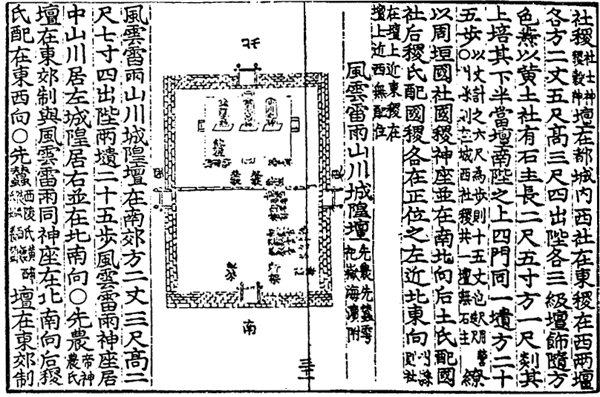
Figure 3 : Altar of Wind, Clouds, Thunder and Rain
be served at a separate Small Rite, 47 In 1426, the famous music theorist Pak
Yon said: "In the ancient system for Wind, Clouds, Thunder and Rain, the
sacrifice for heavenly spirits was not carried out at the same location as one
for [the earthly spirits was Mountains and Streams. But both rites are now
performed at a single altar, and this cannot be seen as fitting." 48 By 1430,
though, Pak had found textual justification for the Korean practice: "Our
nation uses the [Ming] Hungwu lizhi [Ritual System of the Hungwu Period]
provincial rites as authority and performs the sacrifice [to Mountains and
Streams] at the same altar as Wind, Clouds, Thunder and Rain." 49
The Hungwu lizhi states that the spirits of Mountains and Streams hon-
oured in this rite should be local to the "province", and in Korea, the rite re-
ferred broadly to all the mountains and streams of Korea collectively. Choson
also held rites for specific (usually famous) mountains and streams, as noted
in the descriptions of Akhaedok and Myongsan teach'on below.
The Tutelary Spirit (Songhwang) was similarly interpreted to mean a
───────────
47 T'aejong 28.14b (1414/8).
48 Sejong 32.11b-12a (1426/4). Related views are expressed in T'aejong 25.28b-29a (1413/6)
and Sejong 32.9ab (1426/4).
49 Sejong 47.11a (1430/2). cf. Zhang 1579:7.19b-21a.
local Korean spirit rather than a Chinese one, but the explanations in the
sources are not very precise. Korean villagers serve their local guardian spirits
(Sonangsin; the words Sonang and Songhwang are related), but the concept
of a national Tutelary Spirit is nebulous. Grappling with this problem in
1430, Pak Yon confessed to being puzzled as to how Songhwang might be
categorized for musical purposes: "For the Tutelary Spirit , there is no ancient
writing concerning the use of music." 50
2. Akhaedok: Spirits of Mountains, Seas and Streams
In addition to the rite for Korean mountains and streams in general, a
Medium Rite for Mountains, Seas and Streams was performed twice yearly
for a specific set of earthly spirits of four mountains, three seas and seven
streams, all located in or contiguous to Korea. 51 Although this was a
Medium Rite, music was not performed. 52
3. Sonnong: Spirit of Agriculture
The Spirit of Agriculture was human, being that of Shennongshi, a leg-
endary Chinese emperor (traditional date, twenty-seventh century B.C.) con-
sidered to have first taught agriculture. 53 Also honoured at the altar of the
Spirit of Agriculture was the (human) Spirit of Grain, Houtushi, already
mentioned as being served at the altar of the Spirits of Land and Grain
(Sajik).
The altar was located east of the city walls, 54 and performances of the cer-
emony took place once a year in the spring. In connection with the rite, the
king would personally plough a furrow in the East Royal Field (Tongjokchon)
located nearby, 55 the fields normally being tended by a special team of farm-
ers. There was a corresponding West Royal Field (Sojokchon), and the two
Royal Fields were used for growing the grains used as offerings in the various
state rites. 56
───────────
50 Sejong 47.12a (1430/2).
51 Listed in Kukcho orye sorye 1.32a.
52 Sejong 130.21b; Kukcho oryeui 1.99a-102b; Chungbo Munhon pigo 61.21b.
53 Basic classical references in Morohashi 1955:Ⅰ,1011ab.
54 Remains of the last altar (designated a Local Tangible Cultural Property of Seoul City) may
still be seen in a small public park in Yongdu-Dong,Tongdaemun-Gu.
55 For this reason. the ceremony is sometimes referred to as Chokchon (i.e. Royal Field Cere-
mony). A photograph of the last king (emperor) of Choson tilling a furrow is reproduced in
Kim Yongsuk 1987.
56 Sejong 148.2ab.
4. Sonjam: Spirit of Sericulture
Like the Spirit of Agriculture, the Spirit of Sericulture was human: the
person honoured was Xilingshi, principal wife of the legendary Chinese em-
peror Huangdi (traditional1y twenty-seventh century B.C.). She was credited
with having (first taught sericulture. 57 The altar was located east of the city
walls, 58 and the sacrificial rite was performed once a year.
5. Usa: Spirits of the Elements and of Grain
At yet another altar positioned east of the city walls, sacrificial rites
not on a fixed schedule were held to honour the Chinese spirits of the five
elements and the Spirit of Grain: 59
Jumangshi (Wood)
Zhurongshi (Fire)
Houtushi (Earth)
Rushoushi (Metal)
Xuanmingshi (Water)
Houjishi (Grain)
This sacrificial rite presents problems of interpretation: all six of the
spirits are of persons in the period of the legendary Chinese emperors, and
consequently they should be considered human spirits and the sacrifice should
be a hyang. However, the name Usa literally means "rain sacrifice"; rain is
a heavenly phenomenon, and sa is a sacrifice for heavenly spirits.
The fifteenth-century Korean scholars also had difficulty interpreting this
rite, perhaps for the same reasons. Ho Cho, in the 1415 portion of the Orye
uiju, gives a timetable of performances for all the various sacrificial rites,
specifying for each the classification of the spirits as heavenly, earthly, or
human. In this one case, however, he omits the category. 60 In a memorial
of 1430, Pak Yon explains that the spirits should be viewed as human, but
observes that the authoritative 1103 Yueshu (Treatise on Music) of Chen
Yang prescribes the musical instruments appropriate for sacrificial rites for
earthly spirits. 61 The official response to Pak's memorial was to stipulate
───────────
57 Basic classical references in Morohashi 1955:Ⅰ,1006d.
58 Remains of an altar (designated an Historic Site) are still found in Songbuk-Dong, Sangbuk-
ku.
59 Classical references to the spirits of elements are given in Morohashi 1955:Ⅱ, 746b; Ⅷ, 442c:
Ⅱ, 837c; IX, 849c; and Ⅶ, 775d. The spirits of Earth and Grain were also recognized at the
Sacrifice to Spirits of Land and Grain (Sajik), and the Spirit of Grain was also honoured at
the Sacrifice to the Spirit of Agriculture (Sonnong) mentioned above.
60 Sejong 128.2a.
61 Sejong 47.l1b (1430/2). For a complete translation of the memorial, see Provine 1977:329-
"human" music for this rite, 62 and both the 1474 Kukcho orye sorye and
1493. Akhak kwebom (Guide to the Study of Music) certify that this practice
was prescribed. 63
6. Sokchon: Sacrifice to Confucius
On the grounds of the National Confucian Academy (Songgyun'gwan)
in Seoul was a compound of shrine buildings, called Munmyo (Civil Shrine)
or Munsonwang myo (Shrine of Confucius), where a semi-annual Sacrifice
to Confucius was held. This rite was dedicated to human spirits and was
therefore a hyang, and it had the special title Sokchon. It is current practice
to refer to the rite simply as the "Sacrifice to Confucius", since the primary
spirit served is that of Confucius (Kongfuzi), but in fact in the fifteenth
century over a hundred other spirits of canonized Chinese and Korean sages
were also honoured.
In addition to Confucius, particular respect was paid to four primary
disciples: Yan Hui, Zengzi, Zisi, and Mencius (Mengzi). In the first half
of the fifteenth century, 118 other spirits were secondarily honoured: ten
ancient philosophers roughly contemporary with Confucius,105 later Chinese
Confucian sages up to the Song dynasty (including Zhu Xi and five other
neo-Confucianists who were highly respected in Korea) , and three Korean
sages of the seventh to thirteenth centuries. 64 The main shrine building
(Taesongjon) housed the tablets of Confucius, the four disciples and the ten
ancient philosophers. Two long buildings along the east and west sides of
the courtyard in front of the main shrine building held the remaining tablets:
the East Gallery (Tongmu) had fifty-three Tablets of Chinese sages, while
the West Gallery (Somu) had fifty-two Chinese and the three Korean sages.
Figure 4 shows the shrine compound as it appears in the 1474 Kukcho orye
sorye. 65
By the end of Choson an additional fifteen spirits of Korean sages were
honoured in the ceremony. 66 The Sacrifice to Confucius is still performed
today in simplified and abbreviated form, honouring only thirty-nine spirits
───────────
335. The matter of varying instrumentation according to spirit classification is described later
in this essay.
62 Sejong 47.12a (1430/2).
63 Kukcho orye sorye 1.8ab and Akhak kwebom 2.17b.
64 Lists of the persons honoured are given in Sejong 128.3a-4a and Kukcho orye sorye 1.38b-40a.
more information, including date and reason of canonisation for each person, plus additions
up to 1610 is given in Chong Kukhu 1799:1a-10b.
65 Kukcho orye sorye 1.38b-40a.
66 A complete list, with descriptions of the rite as performed during the early twentieth century
are in Murayama 1938:1-25.

Figure 4: Shrine of Confucius
(Confucius, four disciples, ten ancient philosophers, six neo-Confucianists,
and eighteen Korean sages), 67
7. Yoktae sijo: Dynastic Founders
The legendary and historical founders of dynasties in the Korean penin-
sula were remembered at sacrificial rites held twice a year in shrines located
at several sites around the country. 68 Since the ceremonies were similar and
performed on the same days, the several rites were collectively called Sacrifice
to Dynastic Founders. No music was performed at these scattered rites. 69
───────────
67 A description of the modern ceremony and its music is given in Provine 1975. Photographs and
general non-musical information may be found in Palmer 1984. The buildings and compound
have been designated an Historic Site.
68 The persons are listed in Kukcho orye sorye 1.36b-37a.
69 Sejong 128.24a-27b and Kukcho oryeui 2.74a-77b.
Ⅲ. SMALL RITES
1. Myongsan taech'on: Famous Mountains and Great Streams
Performed twice annually, the Sacrifice to Famous Mountains and Great
Streams honoured the earthly spirits of eleven mountains and eight streams
in the Korean peninsula. 70
2. Yongsong: Star of Grain Cultivation
A sacrificial rite for the heavenly spirit of Yongsong, the star said to
watch over grain cultivation, 71 was performed once a year. Closely related
to the spirit of Grain (Houjishi), this spirit was Chinese in origin. Figure 5
shows the altar as depicted in the Kukcho orye sorye. 72 This type of altar,
much simpler than the altars and shrines in Figure 1 through 4, was used
for nearly all of the Small Rites.
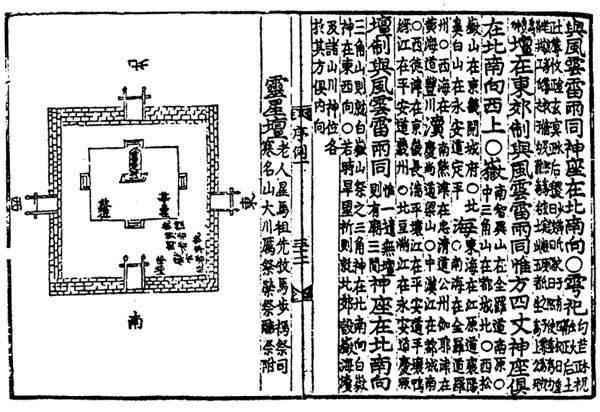
Figure 5: Altar of the Star of Grain Cultivation
───────────
70 Listed in Sejong 128.1b and Kukcho orye sorye 1.36b-37a.
71 Basic references in Morohashi 1955:ⅩⅡ, 92 and Ⅲ, 504c.
72 Kukcho orye sorye 1.32b.
3. Noinsong: Star of Longevity
An annual sacrificial rite was held (or the heavenly spirit of Noinsong, a
star said to be entrusted with control over life expectancy. 73 This rite, like
a few others noted below, is not included in the 1415 Orye uiju, but does
appear in the 1474 works.
4.Majo: Star of Horse Spirits
This and the following three form a group: all are derived from Chinese
tradition, each had an altar east of the city walls, and each was performed
once a year. The sacrifice to the heavenly spirit of the Star of Horse Spirits
was performed in the spring. 74
5. Sonmok: Spirit of the First Horse Domesticator
Performed in the summer, this rite to a human spirit 75 honours the man
who first tamed horses for domestic use. 76
6. Masa: Spirit of the First Equestrian
Performed in the autumn, this rite to an earthly spirit honours the first
man to ride a horse. 77 Although the spirit of a man is normally classified
as human, this spirit was considered earthly since it was said to reside in
Stables. 78
7. Mabo: Spirit of Horse Injury
Performed in the winter, this sacrifice placates the earthly spirit which
does injury to horses. 79 This and P'oje (see below) appear to run contrary to
the usual rule that sacrificial rites in Korea were not performed for malevolent
Spirits.
───────────
73 Morohashi 1955:Ⅸ, 149a.
74 Morohashi 1955:ⅩⅡ, 469d.
75 Sejong 128.2a and 131.27b clearly classify this spirit as human. Kukcho orye sorye 1.1b lists
it as heavenly, but this is surely a misprint, since the Kukcho oryeui, table of contents, 3b,
classifies it as human.
76 Morohashi 1957:Ⅰ, 1012b.
77 Morohashi 1955:ⅩⅡ, 466.
78 Both Sejong 128.2a and Kukcho orye sorye 1.2a classify it as earthly. The stable reference
comes from Kukcho orye sorye 1.33a.
79 Morohashi 1955:ⅩⅡ, 474d.
8. Maje: Sacrifice to the Spirit of War
Performed twice a year on the day before ceremonial military training
exercises (Kangmu), the Sacrifice to the Spirit of War80 honours Chi You, a
militant duke under the legendary Chinese emperor Huangdi.81
9. Yongje : Supplication for Clear Weather
As the counterpart to Supplication for Rain (Kiuje) , the Supplication for
Clear Weather (Yongje or Kich'ongje) was performed at times of excessive
rainfall and water damage. The rite was not carried out at a special altar,
but at the four main gates in the walls of Seoul, As the opposite of the
heavenly phenomenon of rain, clear weather was considered a responsibility
of earthly spirits. 82
10. Sahan: Spirit of Water
A rice for the (human) Spirit of Water (Xuan Ming), who was also served
at the Sacrifice to the Spirits of the Elements and of Grain (Usa), was per-
formed twice yearly on the occasions of preserving ice in an underground
storage chamber: in the (lunar) twelfth month (late winter), when ice was
cut up and put in the storage chamber, and in the second month (spring),
when the doors were again opened to the storage house.
11. Tukche: Spirit of Military Banners
Once a year, a sacrificial rite (Tukche or Tokche) was performed for the
spirit said to reside in military banners. 83 The shrine for this spirit was
located inside the city walls. The existence of hymn texts for this ceremony
indicates that hyangak was at least occasionally performed. 84
───────────
80 This rite is not included in the 1415 Orye uiju, but it had been codified and performed by
1424; see Sejong 23.17ab (1424/2) and the ceremonial programme in 25.27a-28b) (1424/9).
The rite, virtually identical to that for the Spirit of the First Horse Domesticator (Sonmok),
is recorded in Kukcho oryeui 2.81a-84b.
81 Morohashi 1955:Ⅹ,13ab.
82 Kukcho orye sorye 1.33b spceifies "mountains and rivers", which are earthly.
83 Like the rites for the Star of Longevity (Noinsong) and the Spirit of War (Maje), this rite is
not included in the 1415 Orye uiju. It was classified as Small in 1421, as recorded in Sejong
12.26a (1421/7). The programme is recorded in Kukcho oryeui 2.93a-97a.
84 Sejong 147.5b-6a and Kukcho orye sorye 1.11b.
12. Yoje: Unsettled Spirits
The spirits of persons who died by suicide, epidemic disease, or other
abnormal causes were said to be perpetually unsettled. They, together with
human spirits of those who died without descendants (who would normally
perform ancestral rites) and certain earthly Tutelary Spirits (Songhwang) ,
were served in a sacrificial rite performed three times yearly. 85
13. Po'je: Spirit of Crop Calamity
As a counterpart to the Spirit of Horse Injury (Mabo), the spirit causing
injury to humans through crop destruction was served at the altar of the
Spirit of Horse Injury and was considered earthly. The rite was carried out
when needed, specifically in the event of an attack by destructive insects.
Chart 3 summarizes the above list of sacrificial rites in tabular form.
Those rites in which aak was performed are marked with an asterisk.
Non-Musical Aspects
Although the main intent in this article is to show how music fitted into
the scheme of sacrificial rites, it is necessary to avoid the impression that
music was the most important feature of the ceremonies in which it was
used, Music may have been a significant and perhaps particularly noticeable
aspect of the ceremonies, but it was only one of many. The description of
the various components was the purpose of handsomely illustrated rubric
manuals like the 1474 Kukcho orye sorye which accompany the collections
of ritual programme like the Kukcho oryeui. The programmes themselves,
in fact, only map out the succession of ritual events and actions in any
given ceremony; they name, but do not describe, the individual constituents.
Thus, for example, a programme tells precisely when music is to be played,
but doesn't identify what piece of music; it specifies an altar, but describing
the size and construction of the altar is left to the rubrics manuals; offerings
of wine and food are basic to the sacrificial rite, but amounts, vessels, and
arrangements are not specified in the rltual programmes.
The offcial discussions and requests for alteration which we frequently
find in the dynastic Annals are typically concerned with these individual
components, rather than with shortcomings in the basic ritual programmes
themselves. The immense number of such court discussions, from Koryo
through Choson , provide ample material for extended study. Modern schol-
arship in this area, however, is still in a preliminary stage and almost entirely
───────────
85 This rite is not included in the 1415 Orye uiju, even though it had been the subject of
earlier discussion: T'aejong 1.7b-8a (1401/1) and 7.24a (1404/6). A ceremonial programme
is recorded in Sejong 89.36b-39a (1440/6).
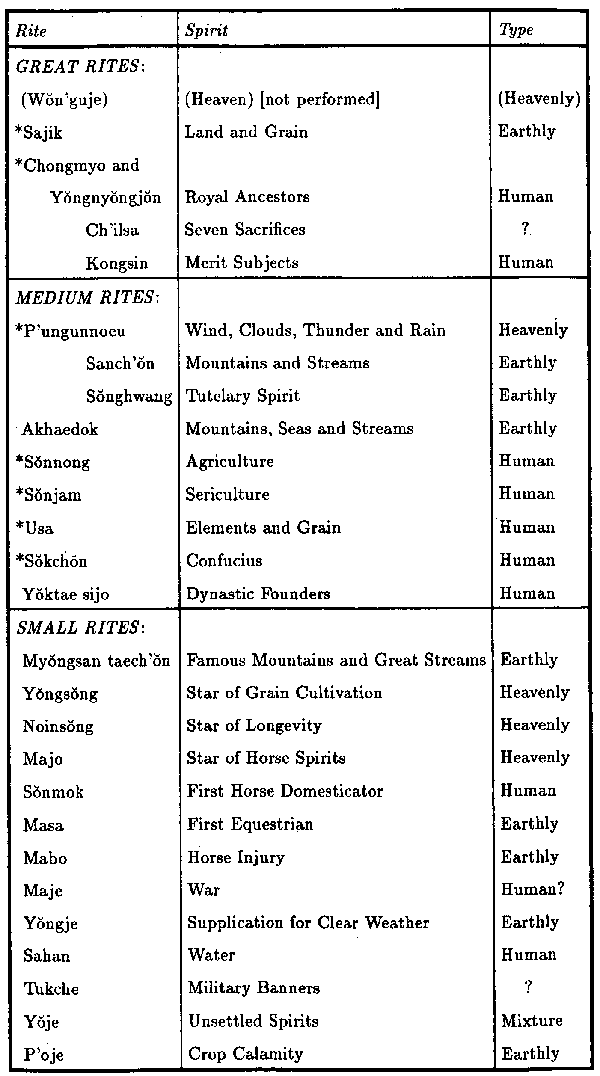
Chart 3: State Sacrificial Rites in Early Choson
in the Korean language, 86 and I shall mention briefly only a few examples of
the non-musical aspects of sacrificial rites.
Discussions of the construction, location and use of shrines and altars
were frequent in the early fifteenth century. There were disputes, for exam-
ple, about whether the sacrifices for the heavenly spirits of Wind, Clouds,
Thunder, and Rain (P'ungunnoeu) should be combined at a single altar with
sacrifices to the earthly spirits of Mountains and Streams (Sanch'on), or
whether there should be separate altars. The physical shape and size of al-
tars (such as that in Figure 5) were often argued, with proponents of each
viewpoint citing a different Chinese textual authority. 87 Even the subject of
local altar construction in the provinces received a good deal of ministerial
attention in the capital. 88
Vessels, tables and other ritual implements used in carrying out rites
were manufactured only after meticulous study. 89 Whenever possible, the
responsible ministers referred to illustrated Chinese sources for authority.
For example, Figure 6, from the 1415 Orye uiju, shows three jars and a ladle:
for each item there is descriptive information cited from Chinese sources. 90
In this case, the quoted sources (all of which contain drawings) are Zhu
Xi's Shaoxi zhouxian shidian yitu [Illustrated Descriptions of the Provincial
Sacrifices to Confucius in the Shaoxi Period] of 1194, the anonymous Zhouli
jingtu [Illustration Related to the Rites of the Zhou Dynasty) of ca. 1110,
and Chen Xiangdao's Lishu (Treatise on Rites) of 1090. 91
A particularly visible aspect of sacrificial rites was the ritual garments.
Each participant wore robes and ornaments appropriate to his rank and
role. Figure 7, again from the Orye uiju, shows the king's emblem of office,
headdress, and outer robe (front and rear views) for sacrificial rite use. 92
The material, colours and decoration of such ritual garments were often the
subject of discussion at court.
Other aspects of the sacrificial rites included spirit tablets (wood or stone
────────────
86 Two exceptional studies of specific rites, however, have already been mentioned several times:
Hwang Kyonghwan 1967 on the Royal Ancestral Shrine and Murayama 1938 on the Sacrifice
to Confucius.
87 An extended discussion of altar construction, wish a comparison of Chinese sources and his-
torical precedents, is recorded in Sejong 57.25b-27b (1432/9).
88 For example, Sejong 50.29a (1430/12) and 76.24a-27a (1437/3),
89 Nam Kisuk 1971 is a comprehensive study of ritual vessels at the Sacrifice to Confucius
(Sokchon), with references to historical sources. Munhwa kongbobu 1976 is a similar atudy
for the Royal Ancestral Shrine (Chongmyo) .
90 Sejong 128.8b.
91 These works are all described in Provine 1988.
92 Sejong 128.29a.
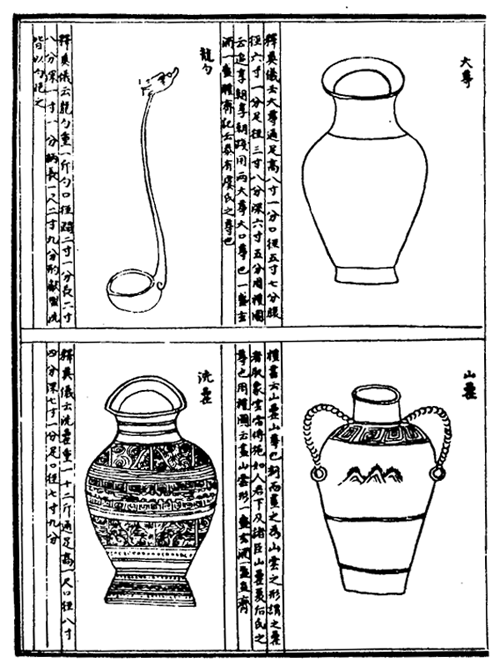
Figure 6: Ritual Jars and Ladle
slabs engraved with the name of a spirit and used at sacrificial rites an
embodiment of the spirit) ; selection and preparation of offering meats, grains
and cloth; arrangement of the offered items on tables; incense·, processions
to and from the palace; and the choice and purification of participants.
The Basic Ceremonial Programme
In the Great and Medium Rites, the central ritual actions were three
offerings of wine (chakhon) presented to the honoured spirits so that they
could sample the essence. The importance of these wine offerings is attested
by the space devoted to them in the programmes contained in both the
1415 Orye uiju and the 1474 Kukcho oryeui. Usually presented to each
spirit individually, the wine offerings occupied a large proportion of the time

Figure 7: King's Ritual Garments
in rites such as those at the Royal Ancestral Shrines which served a large
number of spirits.
Specific "offering officiants" (hon'gwan) were designated for each sacrifi-
cial rite. 93 Ideally, in Great and Medium rites the king was the First 0ffering
Officiant (Ch'ohon'gwan), the Crown Prince was the Middle Offering Offi-
ciant (Ahon'gwan), and a high minister with Senior 1 rank (Chongil p'um)
was the Final Offering Officiant, If the king was unable to attend, the crown
price could serve as First Offering Officiant , with high-ranking ministers as
Middle and Final Offering Officiants. If neither king nor crown prince could
attend, a "proxy rite" (sopsaui) was performed with high ministers filling all
───────────
93 A list of required offering and other celebrants in all the sacrificial rites is given in
Kukcho orye sorye 1.14a-23a.
the officiant roles.
The three offerings of wine were preceded in the ceremonial programme
by an Offering of Tribute (Chonp'ye) in which lengths of cloth were presented
to the spirits, and an Offering of Sacrificial Food (Chinch'an) in which various
grains, meats and other foodstuffs were presented. Following these five parts
of the ceremony was a section Removing the Vessels (Ch'olbyondu) in which
the tables were moved back away from the tablets of the spirits being served.
The offering officiants and other celebrants stood in the courtyard of
the shrine building or came down from the altar at the times they were
not actually participating in ceremonial actions. Before entering a shrine or
ascending the mound at an altar, each offering officiant performed a ritual
purification, Cleansing the Hands (Kwanse). procession into the shrine or
onto the mounds of an altar was called Ascending Into the Shrine (Sungjon),
the reverse Descending from the Shrine (Kangjon).
As a frame around the various ritual acts were an opening section, Wel-
coming the Spirits (Yongsin), and a closing section, Usherinly Out the Spir-
its (Songsin), which symbolized the honoured spirits' arrival and departure.
Chart 4 summarizes the basic programme of the Great and Medium sacrificial
rites, omitting subsidiary acts of cleansing and procession.

Chart 4: Basic Programme of a Sacrificial Rite
Music and Dance in the Ritual Framework
Ritual programmes in the 1474 Kukcho oryeui prescribe music only for
the eight basic sections of a sacrificial rite listed in Chart 4. 94 An under-
standing of the way in which music and dance fit into the ritual framework
requires an investigation of five topics: the application of formal music ti-
tles to sections of the programme, the alternation of two contrasting musical
ensembles, the choice of modes and tonal centres, the use of two dance en-
sembles, and the texts sung in the ritual music.
Ⅰ. SECTIONAL MUSIC TITLES
Each basic section of a sacrificial rite had attached to it a formal music
title, The title pertained to the section of the ceremony and was not in
itself a precise identification of the piece of music to be played. For example,
music performed during the Offering of Tribute (Chonp'ye) at the Sacrifice to
Confucius (Sokchon) was entitled Myongan chi kok [Music of Bright Peace],
regardless of what piece of music might be performed.
A number of titles were common to all the sacrificial rites except the
Sacrifice to Confucius (which, as we shall increasingly see, was exceptional in
a number of ways): for the internal sections from Offering of Tribute through
Removing the Vessels, the standard titles were as shown in Chart 5.
The music titles for the two outer sections (Welcoming the Spirits and
Ushering out the Spirits) depended on the category of spirit honoured:

Chart 6: Formal Music Titles in Outer Sections
───────────────
94 Earlier sacrificial rites, such as those recorded in the 1415 Orye uiju (Sejong 129-130) and the
Koryosa(chap. 59-62), also stipulated music for the cleansing and processional sections. It
seems, therefore, that the amount of music performed at sacrificial rites decreased during the
rule of King Sejong. Further evidence for this view may be found in an early Royal Ancestral
Shrine ceremonial programme of 1422, which, like the earlier Orye uiju, prescribes music
for cleansing and processionals (Sejong 24.20a-27a [1422/6]), and in a late. Royal Ancestral
Shrine programme of 1442, which limits music to the eight basic sections (Sejong 98.14a-l6a
[1442/11]).
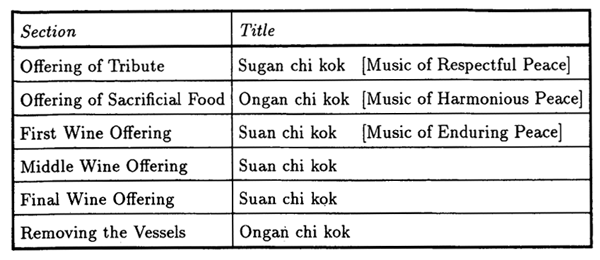
Chart 5: Sectional Music Titles in Internal Sections
There were exceptions to the preceding schemes: the Sacrifice to Confu-
cius had its own unique set of formal titles, and three rites (for Sericulture,
for Elements and Grain, and for Wind, Clouds, Thunder and Rain) did not
employ music in the Offering of Sacrificial Food section. 95 Chart 7 summa-
rizes the formal titles as found in the seven sacrificial rites which used aak
(the names have been abbreviated by omitting "chi kok" ["Music of ..."] at
the end of each).
A certain symmetry in labelling is evident from Chart 7· the arrival and
departure of the spirits are given the same title, as are the presentation and
removal of sacrificial foods (except in the case of the Sacrifice to Confucius) .
All three wine offerings share the same label.
The authorship of the formal music titles is less certain than is their
application. Those (or the Sacrifice to Confucius were borrowed from Song
dynasty China, 96 and those for the other rites were apparently devised in
Korea. All the labels were already In use in the 1415 Orye uiju, but with no
────────────
95 As demonstrated in the lists of musical sections in Kukcho orye sorye 1.6b-9a and Akhak
kwe bom [Guide to the Study of Music] 2.16b-l8b.
96 They may be identified with the Dasheng Institute (Dashengfu) titles recorded in the Songshi
(History of the Song Dynasty) 137.3236-3238 and those on the "old" texts in the Yuanshi
(History of the Yuan Dynaety) 69.1738-1743. 1 have Not found either standard history specif-
ically cited in Korea as a musical or ritual source until late in the fifteenth century (e.g.Akhak
kwebom 7.20b), but it is known that both works were in Korea at least by 1417: T'aejong
34.35a (1417/12). There are two textual problems wish the titles. First, the name Songan
for Middle and Final Offerings is apparently erroneous, but perpetuated in Korea. It is given
as Munan ("Civil Peace") in Lin Yu's 1349 Dasheng yuepu [Collection of Dasheng Music]
(Sejong) as well as in the Songshi 137.3238 and Yuanshi 69.1742. The tit1e Songan,
however, is already in use in Korea in the 1415 Orye uiju (Sejong 131.18a and 21a), reap-
pearing later in the Kukcho oryeui 2.54a, Kukcho orye sorye 1.8b,and Akhak kwebom 2.18b.
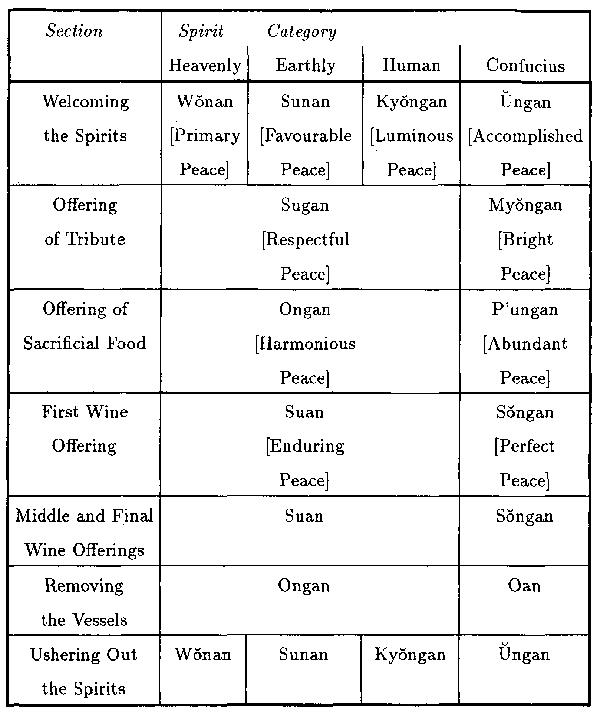
Chart 7: Sectional Music Titles
──────────────
96 Using Munan creates an inconsistency relative to the other sacrificial rites which all use the
same title for all three wine offerings; however, suck an inconsistency is already present in the
Sacrifice to Confucius in the titles for Offering of Sacrificial Food (p'ungan) and Removing
the Vessels (Oan), The second problem is the title Ungan for Ushering Out the Spirits: this
reading is confirmed by the Songshi 137.3235-3239 and elsewhere, as well as by the Yuanshi
69.1742 and the basic Korean sources Kukcho orye sorye 1.9a and Akhak kwebom 2.18b. The
appearance of the title Yongan in place of Ungan in the Dasheng yuepu (Sejong 137.27b) and
hint of their genesis. 97
Whoever devised the Korean music titles clearly modelled them after
Song precedent, Examination of the hymn texts recorded in the Chinese
dynastic histories shows that each dynasty normally had one or a very few
recurrent characters in its music titles for sacrificial rites. Almost without
exception the hundreds of such titles in the Songshi 98 on the character an
( "peace") as their second syllable. Titles in the Yuanshi 99 on the other
hand, mostly use cheng (Korean song, "complete" ) or ning (Korean nyong,
"peaceful" ). In the case of the Mingshi (History of the Ming Dynasty), 100 the
repeating character is he (Korean hwa, "harmony" ). All the Korean titles
in Chart 7 have an (Peace) as their second syllable, so it is clear that Song
provided the model for Korea, not surprising in light of the generally heavy
Korean reliance on Song dynasty written texts on musical matters. 101
ll. COURTYARD AND TERRACE ENSEMBLES.
In each sacrificial rite utilizing music there were two performing ensem-
bles: a Courtyard Ensemble (honga) and a Terrace Ensemble (tungga). The
Terrace Ensemble was positioned on the elevated stone porch of a shrine
or just below the steps leading to the earthen mound of an altar, and the
Courtyard Ensemble was located at the entry end of the courtyard of the
shrine or altar. The essential components of the Terrace Ensemble were
singers and string instruments, while the Courtyard Ensemble had sets of
bells (p'yonjong) and stone chimes (p'yon'gyong), combined with wind in-
struments.
Only one ensemble performed during a given section of a sacrificial rite,
the ensembles generally alternating sections. Perhaps because the Middle
and Final Wine Offerings were secondary acts (by comparison with the First
Offering conducted personally by the king), the Courtyard Ensemble per-
formed for both in succession The basic plan is shown in Chart 8.
As already mentioned, the Sacrifices to Sericulture, to Elements and
Grain, and to Wind, Clouds, Thunder and Rain did not have music in the
Offering of Sacrificial Food, so the alternation of Terrace and Courtyard was
──────────────
1415 Orye uiju (Sejong 131.18b and 21b) is curious. In any case, the set of titles shown in
Chart 7 is still used in the modern ceremony; see Provide 1977:60-61. Every scholarly article
deserves an over-indulgent footnote: you've just read the one in this article.
97 Sejong 129-131 Passim.
98 Chapters 132- 139.
99 Chapter 69.
100 Chapter 62
101 Provine 1988: 101-174.
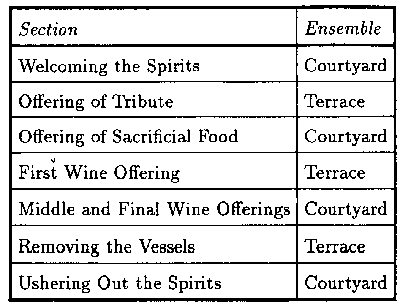
Chart 8: Programme Sections and Ensembles
less regular in those ceremonies.
It should be noted that while the Offering of Sacrificial Food and Re-
moving the Vessels share the same formal music title, they are performed by
different ensembles (and, as explained below, in different tonal centres). The
same is true of the First Wine Offering as compared to the Second and Final
Wine Offerings.
1. Courtyard Ensemble
The name and organisation of the Courtyard Ensemble are taken from
statements in the classic text Zhouli (Rites of the Zhou Dynasty) and its early
commentaries, The main text says, "As to the set-up of correct musical en-
sembles: the .use. has a 'palace ensemble'(gongxuan, Korean kunghyon);
the several dukes have a 'pavilion ensemble'(xuanxuan, Kor. honhyon); im-
portant local officials have a 'half ensemble'(panxuan, Kor. p'anhyon); and
gentlemen have a 'special ensemble'(texuan, Kor. tukhyon).102 In the Con-
fucian hierarchy, Korea was a ritual "duke" relative to the Chinese "ruler" ,
and hence it was appropriate at the royal level for Korean sacrificial? rites to
use a "pavilion ensemble". The character hyon (xuan) in each name means
"suspend" or "hang" , and in the Zhouli it may have referred to the sets
of bells and $tone chimes suspended in their frames. This is the interpre-
tation of the above passage given by the Han dynasty commentator Zheng
Xuan. In the Korean term 77n'7a, the character hyon has been replaced by
───────────
l02 Zhouli 23.5a.
ka/ga, meaning a "frame", in which, for example, bells or chimes could be
suspended .
Zheng Xuan gives us practical information on the ensembles: "The 'pal-
ace ensemble 'has thou. sides of (bell and chime) frames; the 'pavilion ensemble'
subtracts one side, the 'half ensemble' subtracts another side, and the 'rope-
cial ensemble' also subtracts another side." l03 Zheng's comment was later
interpreted, as in Chen Yang's Yueshu (Treatise on Music) of 1103, as mean-
ing that the arrangements of bells and chimes formed , respectively, the four
sides of a square, three sides, two parallel lines, and a single line.104 The bells
and chimes acted as an outer enclosure, within which various wind instru-
ments were set out in horizontal rows. The Koreans took Chen's ensemble
diagrams as a model for their own, decreasing the size slightly: Chen's de-
tailed diagram of a Courtyard Ensemble for the (Chinese) emperor has nine
rows of twelve instruments each inside the bell and chime boundaries, 105 and
in Korea the number of rows remained the same, but each contained only
ten instruments.
The Courtyard Ensembles in the 1415 Orye uiju and 1474 Kukcho orye
sorye are nearly identical, the only differences being the latter's addition of
two large drums (chin'go) and three hand-held drums.106 Figure 8 shows
the Courtyard Ensemble for the sacrificial rite to Spirits of Land and Grain
(Sajik), as given in the Kukcho orye sorye.107 The three-sided enclosure by
bells and chimes is clearly shown, as are the nine rows of instruments (flutes,
mouth organs, pan-pipes, ocarinas, and clay vessels). 108 Two large drums
(chin'go) are shown at the top of the diagram, and more drums are located
at the top two corners of the square, above the top side of bells and chimes.
There is (inevitably?) a problem with the diagram in Figure 8: in the
1415 and 1474 Korean sources, as well as in Chen Yang's 1103 Yueshu,109
there are a number of individual, pitched bells and chimes interspersed among
the sets of bells and chimes around the perimeter of the ensemble. While
───────────
103 Zhouli 23.5a.
104 Yueshu 113.7a-8b and 9b-10a.
105 Yueshu 113.2b.
106 Sejong 128.23a. Addition of the chin'go was approved after Pak Yon proposed it in a memorial:
Sejong 47.12b-l3a. Descriptions and illustrations of the hand-held drums do appear in the
1415 work (Sejong 128.18b-l9a), suggesting that their absence from the ensemble diagrams
there is merely an error of compilation or copying. The use of hand-held drums is described
below.
107 Kukcho orye sorye 1.91a.
108 Description of all the instruments is beyond the scope of this article, All are included in Sadie
1985, though the best source of derailed information is Akhak kwebom chapter 6.
109 Yueshu 113.2b and 7ab.
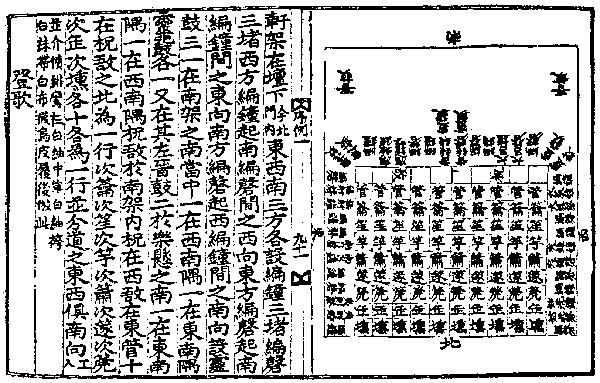
Figure 8: Courtyard Ensemble
both the Korean works provide a textual description of the ensembles, neither
mentions the individual bells and chimes by the names given in the drawing.
One possible explanation is that they were appropriately tuned versions of the
instruments known as t'ukchong (single bell) and t'ukkyong (single chime)·
We know that Pak Yon petitioned for the manufacture of individual bells
and chimes in 1430, but his request was turned down.110 It remains doubtful
that such instruments were ever actually used in the Courtyard Ensemble.111
At the end of the century, the Akhak kwebom reproduces the 1474 diagram
complete with individual bells and chimes, but a couple of pages later presents
a revised diagram based on contemporary practice, which omits them.112
There were some minor variations in the various Courtyard Ensembles
for sacrificial rites. The Courtyard Ensemble was directionally orientated : as
indicated in figure 8, the ensemble for the Spirits of Land and Grain (Sajik)
was located north of the altar and faced toward the south. All the other
───────────
110 Sejong 47.12ab (1430/2).
111 Lee Hye-Ku (Yi Hyigu), basing his argument on the known numbers of performs used in
the ensembles, suggests that there were too few players for the individual bells and chimes to
have actually been part of the Courtyard Ensemble; Yi Hyigu 1967:161.
112 Akhak kwebom 2.1a and 3a.
sacrificial rites used the opposite orientation. 113
The drums used in an ensemble were a function of the category of spirit
being honoured. For heavenly spirits, a triple drum in a wooden frame
(noego) and a hand-held triple drum on a stick (noego) were used. For
earthly spirits a quadruple drum (yonggo) and hand-drum (yondo), and
for human spirits a double drum (nogo) and hand-drum (nodo) were pre-
scribed.114 According to the Orye uiju and Kukcho orye sorye, the sacrifice
to the Spirit of Agriculture (a human spirit) was exceptional, substituting an
"earthen drum" (t'ogo) for the double drum (nogo); in the Akhak kwebom,
the more usual double drum was prescribed. 115
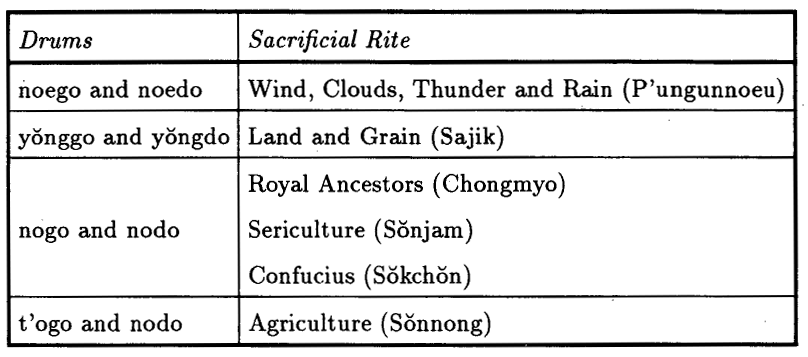
Chart 9: Drums in Courtyard Ensembles, Sejong Period
Another inconsistency in instrumentation involved one row of melodic
instruments: in Figure 8, the third internal row of instruments in the Court-
yard Ensemble for the Sacrifice to Spirits of Land and Grain consists of ten
mouth organs called saeng. The other six sacrificial rites, however, had seven
saeng and three smaller mouth organs called hwa. 116
───────────
113 Kukcho orye sorye 1.94ab.
114 The Kukcho orye does not include Royal Ancestors in its diagrams of ensembles, since
it was written after King Sejo had substituted hyangak for aak in that ceremony. In the time
of King Sejong, though, the enselnbles at the Royal Ancestral Shrine were uniform with the
other aak ensembles.
115 Orye uiju sorye 1.94ab. In the 1415 Orye sorye 1.78a-79a and Akhak kwebom 2.3a.
116 Kukcho orye sorye 1.94ab. In the 1415 Orye uiju, the ensemble for the Spirits of Wind,
Clouds, Thunder and Rain has ten hwa in third row (Sejong 128.24b), but this practice
is not mentioned in the later Kukcho orye sorye or Akhak kwebom.
Whatever small distinctions might have existed amongst the various in-
dividual ensembles, any one Courtyard Ensemble, with eighteen full sets of
bells and chimes plus an even hundred other instruments, could hardly have
foiled to provide an imposing spectacle and grandiose sound.
2. Terrace Ensemble
The Zhouli and its commentaries tell us comparatively little about the
Terrace Ensemble, though the name (tungga) does occur and is glossed by
Zheng Xuan simply as "singers at the shrine". 117 The Terrace Ensemble
depicted in Chen Yang's Yueshu of 1103 consists essentially of forty-eight
singers, twelve seven-string zither (qin, Korean kum), twelve twenty-five-
string zither (se, Kor. sul), a single bell tuned to the fundamental pitch,
and a single stone chime tuned an octave higher. 118 In the fifteenth century,
the Koreans started with Chen's ensemble, appropriately reduced in size, and
subsequently they added more instruments to it.
Figure 9 show the Terrace Ensemble as given in the 1415 Orye uiju:119
there are twenty-four singers, plus six kum, six sul, one bell instrument (ka-
jong), and one chime instrument (kagyong). The Orye uiju explains else-
where that the kajong is simply a single bell, t'ukchong, and the kagyong a
single chime, t'ukkyong, 120 but this interpretation was later felt to be erro-
neous, as explained in a memorial recorded in the Annals for 1430: 121
The Board of Rites (Yejo), based on a petition from the Music School (Akhak),
presented a memorial:
"In aak, the melody of the Terrace Ensemble [singers] fellows exactly the rise
and fall of pitches on the [stringed instruments] kum and sul. But the sounds of
the kum are thin, weak and hard to hear. Similarly, the sounds of the sul are
produced simultaneously with the singing of twenty-four persons: the vocal sounds
are overpowering, and it has not been possible to distinguish the tones, be that the
result is not properly balanced.
"We have researched the ancient system: in ensemble diagrams, the Terrace
Ensemble has one set each of p'yonjong and p'yon'gyong. The Zuozhuan(Commen-
taries of Zuo) says,'The men of Zheng bribed the lords of Jin with two full sets of
───────────
117 Zheuli 23.7a.
118 Yueshu 113.2a Actually both the 1782 Siku quanshu and 1876 collated edition of the Yueshu
slow only forty-four singers, eleven qin and eleven se, but this is surely a printing error. Ma
Duanlin's Wenxian tongkao (Comprehensive Investigation of Documents and Institutions) of
ca. 1319, 140.1235a, quoting Chen Yang, gives forty-eight, twelve and twelve.
119 Sejong 128.25a.
120 Sejong 128.20b.
121 Sejong 47.26a (1430/3). Although Pak Yon is not specifically mentioned in connection with
this memorial, he held posts in 1430 in both the Music School and the Office of Sacrificial
Rites (Pongsangsi) and would have been closely involved with the training of singers.

